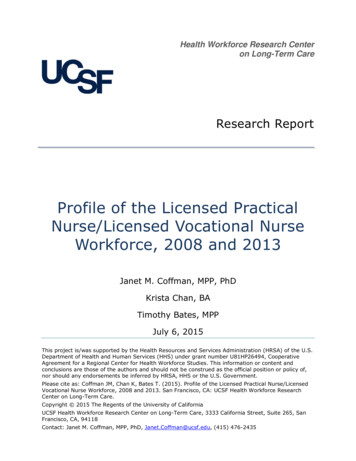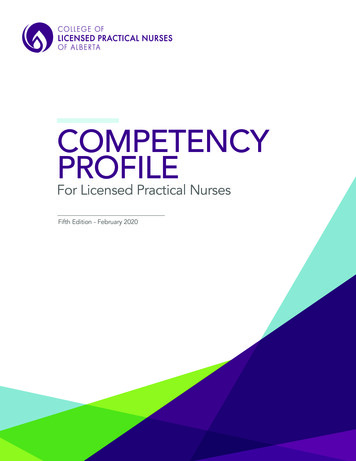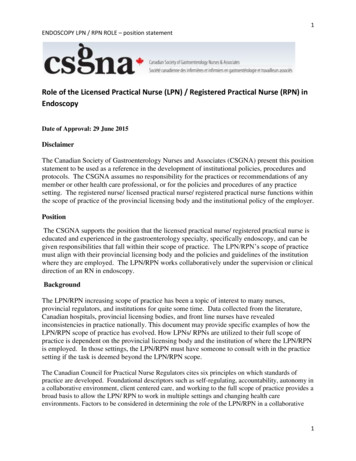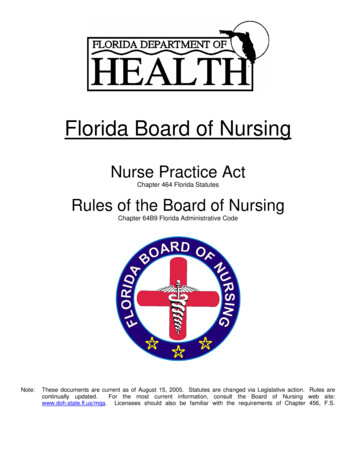
Transcription
Health Workforce Research Centeron Long-Term CareResearch ReportProfile of the Licensed PracticalNurse/Licensed Vocational NurseWorkforce, 2008 and 2013Janet M. Coffman, MPP, PhDKrista Chan, BATimothy Bates, MPPJuly 6, 2015This project is/was supported by the Health Resources and Services Administration (HRSA) of the U.S.Department of Health and Human Services (HHS) under grant number U81HP26494, CooperativeAgreement for a Regional Center for Health Workforce Studies. This information or content andconclusions are those of the authors and should not be construed as the official position or policy of,nor should any endorsements be inferred by HRSA, HHS or the U.S. Government.Please cite as: Coffman JM, Chan K, Bates T. (2015). Profile of the Licensed Practical Nurse/LicensedVocational Nurse Workforce, 2008 and 2013. San Francisco, CA: UCSF Health Workforce ResearchCenter on Long-Term Care.Copyright 2015 The Regents of the University of CaliforniaUCSF Health Workforce Research Center on Long-Term Care, 3333 California Street, Suite 265, SanFrancisco, CA, 94118Contact: Janet M. Coffman, MPP, PhD, Janet.Coffman@ucsf.edu, (415) 476-2435
UCSF Health Workforce Research Center on Long-Term CareResearch ReportProfile of the Licensed Practical Nurse/Licensed Vocational NurseWorkforce, 2008 and 2013Table of ContentsTable of Contents . 2Table of Tables . 4Table of Figures . 5Executive Summary . 7Methods . 7Results . 7Employment Patterns . 7Demographic Characteristics . 7Differences among Census Regions . 8Differences between Metropolitan and Non-Metropolitan Areas . 8Recommendations . 9Background . 10Methods. 10Data . 10Defining Sector and Occupation . 11Results . 11Employment Characteristics of Licensed Practical Nurses . 11Demographic Characteristics of Licensed Practical Nurses . 15Age. 15Gender . 17Race/Ethnicity . 17Nativity . 20Speaking a Language Other than English . 22Educational Attainment . 232
UCSF Health Workforce Research Center on Long-Term CareResearch ReportCharacteristics of Licensed Practical Nurses by Census Region . 24Characteristics of Licensed Practical Nurses in Metropolitan vs. Non-MetropolitanAreas . 31Conclusions . 37Limitations . 38Future Directions . 39Acronyms Used in this Report . 40References . 41Data . 42Geocoding Public Use Microdata Areas (PUMA) using Rural Urban ContinuumCodes (RUCC) . 42Defining Sector and Occupation . 443
UCSF Health Workforce Research Center on Long-Term CareResearch ReportTable of TablesTable 1. LPNs by Age Group, United States, 2008 and 2013 . 15Table 2. LPNs by Employment Status within Age Group, United States, 2013. 16Table 3. LPNs by Race/Ethnicity and Age Range, 2013, United States . 20Table 4. Employed LPNs by Educational Attainment, United States, 2008 and 2013. 23Table 5. Employed LPNs by Educational Attainment and by Industry (LTC versusNon-LTC), United States, 2013 . 24Table 6. Employed LPNs by Age Range and by Census Region, 2013 . 27Table 7. Employed LPNs by Race/Ethnicity and by Census Region, 2013 . 28Table 8. Employed LPNs by Educational Attainment and by Census Region, 2013 . 30Table 9. Employed LPNs by Age Range and by Metropolitan vs. Non-MetropolitanArea, 2013 . 33Table 10. Employed LPNs by Educational Attainment and Metropolitan vs. NonMetropolitan, 2013 . 36Appendix Table 1. Census and NAICS crosswalk for selected Long-term Care sectors. 45Appendix Table 2. American Community Survey, Public Use Microdata Samplecounts by selected characteristics . 454
UCSF Health Workforce Research Center on Long-Term CareResearch ReportTable of FiguresFigure 1. Employment Status of LPNs, United States, 2008 and 2013 . 12Figure 2. Employed LPNs by Industry, United States, 2008 and 2013 . 13Figure 3. Employed LPNs by Employment Setting and LTC Employment Setting,United States, 2013 . 14Figure 4. LPNs Employed in Long-term Care by Setting, United States, 2008 and2013 . 15Figure 5. Employed LPNs by Gender, United States, 2008 and 2013 . 17Figure 6. Employed LPNs by Race/Ethnicity, United States, 2008 and 2013 . 18Figure 7. Employed LPNs by Race/Ethnicity and by Industry (LTC versus Non-LTC),United States, 2013 . 19Figure 8. Employment Status of LPNs by Race/Ethnicity, United States, 2013 . 19Figure 9. Employed LPNs by Nativity, United States, 2008 and 2013 . 21Figure 10. Employed LPNs by Nativity and by Industry (LTC versus Non-LTC),United States, 2013 . 21Figure 11. Employed LPNs by Language Spoken at Home, United States, 2008 and2013 . 22Figure 12. Employed LPNs by Non-English Language Spoken at Home, UnitedStates, 2013 . 23Figure 13. Employment Status of LPNs by Census Region, 2013 . 25Figure 14. Employed LPNs by Industry and by Census Region, 2013 . 26Figure 15. LPNs Employed in Long-Term Care by Work Setting and by CensusRegion, 2013 . 27Figure 16. Employed LPNs by Nativity and by Census Region, 2013 . 29Figure 17. Employed LPNs by Language Spoken at Home and by Census Region,2013 . 30Figure 18. Employment Status of LPNs by Metropolitan vs. Non-Metropolitan Area,2013 . 31Figure 19. Employed LPNs by Industry and by Metropolitan vs. Non-MetropolitanArea, 2013 . 32Figure 20. LPNs Employed in Long-Term Care by Setting and by Metropolitan vs.Non-Metropolitan Area, 2013 . 32Figure 21. Employed LPNs by Census Region and by Metropolitan vs. NonMetropolitan Area, 2013 . 33Figure 22. Employed LPNs by Gender and by Metropolitan vs. Non-MetropolitanArea, 2013 . 345
UCSF Health Workforce Research Center on Long-Term CareResearch ReportFigure 23. Employed LPNs by Race/Ethnicity and by Metropolitan vs. NonMetropolitan Area, 2013 . 35Figure 24. Employed LPNs by Nativity and by Metropolitan vs. Non-MetropolitanArea, 2013 . 35Figure 25. Employed LPNs by Language Spoken at Home and Metropolitan vs. NonMetropolitan Area, 2013 . 366
UCSF Health Workforce Research Center on Long-Term CareResearch ReportExecutive SummaryLicensed practical nurses (LPNs), referred to as licensed vocational nurses (LVNs) insome states, are the second-largest health care occupation that requirespostsecondary education. More LPNs work in long-term care (LTC) than in any othersector. Demand for LPNs among long-term care providers is expected to increasesubstantially over the next several decades. Thus, there is a need to betterunderstand recent trends in the LPN workforce and their implications for the futuresupply of LPNs available to provide long-term care.This report updates previous studies of the LPN workforce by presenting the latestnational data available on LPN employment patterns with emphasis on employmentin long-term care. The report also describes trends in the demographiccharacteristics and educational attainment of LPNs.MethodsData from the 2008 and 2013 American Community Survey (ACS), Public UseMicrodata Sample were analyzed.ResultsEmployment PatternsBetween 2008 and 2013: The number of LPNs in the United States decreased by 6%The number of LPNs employed by LTC providers increased by 13% andthe number employed by hospitals decreased by 20%Most of the growth in LPN employment in LTC was due to a 58%increase in the number of LPNs employed by home health agenciesDemographic CharacteristicsBetween 2008 and 2013: The age distribution of LPNs did not change significantlyThe LPN workforce remained predominantly female7
UCSF Health Workforce Research Center on Long-Term CareResearch Report There was a small increase in the percentage of LPNs who wereHispanic or Latino and a small decrease in the percentage who werewhiteThe percentages of LPNs who were foreign-born or spoke a languageother than English at home increasedThe percentage of African Americans in the LPN workforce was higherthan in the general population, especially among LPNs working in longterm careThe racial/ethnic diversity of the LPN workforce is likely to increase inthe coming decades because non-White LPNs are younger, on average,than white LPNs and, thus, likely to remain in the labor force longerDifferences among Census RegionsIn 2013: LPNs in the West region were more likely to work in hospitals and lesslikely to work in LTC settings than LPNs in the Northeast, Midwest, andSouth regionsWithin the LTC sector, LPNs in the South and West regions were morelikely to be employed by home health agencies and less likely to beemployed by skilled nursing facilities than LPNs in the Northeast andMidwest regionsThe LPN workforce in the South and West regions was younger thanthe LPN workforce in the Northeast and the Midwest regionsThe South and the West regions had the largest percentages of nonWhite LPNs; the South region had the largest percentage of AfricanAmerican LPNs, while the West region had the largest percentage ofHispanic or Latino LPNsThe Northeast and the West regions had the largest percentages ofLPNs who were foreign born or who spoke a language other thanEnglish at homeDifferences between Metropolitan and Non-Metropolitan AreasIn 2013: LPNs in metropolitan areas were less likely to be employed in LTCsettings than LPNs in non-metropolitan areas8
UCSF Health Workforce Research Center on Long-Term CareResearch Report Within the LTC sector, LPNs in metropolitan areas were less likely to beemployed by skilled nursing facilities than LPNs in non-metropolitanareasThe percentage of male LPNs was greater in metropolitan areas than innon-metropolitan areasLPNs in metropolitan areas were more racially/ethnically diverse, morelikely to be foreign-born, and more likely to speak a language otherthan English at home compared with LPNs in non-metropolitan areasRecommendationsThis analysis suggests that the total number of LPNs in the United States isdecreasing and that employment patterns are changing. The number of LPNsemployed by hospitals has decreased significantly while the number employed inlong-term care settings has increased. Within the long-term care sector, LPNemployment has grown most substantially in home health care settings.The growth in demand for LPNs in long-term care settings relative to hospitals hasimportant implications for LPN education. LPNs who work in long-term care settingshave less direct supervision than their counterparts in hospitals and need toexercise more independent judgment regarding patient care. LPN educationprograms need to ensure that students obtain sufficient clinical training in longterm care settings and have the critical thinking and communications skillsnecessary to practice effectively in these settings.The findings from this analysis also suggest that there are some importantdifferences in LPN employment patterns between Census regions and betweenmetropolitan and non-metropolitan areas. Further research is needed to assess theextent to which these differences are related to differences in state policiesregarding healthcare staffing, reimbursement for healthcare services, or othercharacteristics of healthcare markets.9
UCSF Health Workforce Research Center on Long-Term CareResearch ReportProfile of the Licensed Practical Nurse/Licensed Vocational NurseWorkforce, 2008 and 2013BackgroundLicensed practical nurses (LPNs), referred to as licensed vocational nurses (LVNs) inCalifornia and Texas, are the second-largest healthcare occupation that requirespostsecondary education. More LPNs work in long-term care (LTC) than in any othersector. The majority of LPNs are employed by skilled nursing facilities, but they arealso employed by other long-term care providers, such as home health agenciesand residential care facilities.Growth in demand for long-term care services for the aging population of theUnited States is likely to increase demand for LPNs in the coming decades. Thenumber of LPNs employed in long-term care is projected to increase by 70%(approximately 70,000 LPNs) between 2010 and 2030.1 Thus, there is a need tobetter understand recent trends in the LPN workforce and their implications for thefuture supply of LPNs available to provide long-term care.This report updates previous studies of the LPN workforce2,3 by presenting the latestnational data available on LPN employment patterns with emphasis on employmentin long-term care. Employment patterns in 2008 are compared with employmentpatterns in 2013 to identify major trends in LPN employment over this time period.The report also describes trends in the demographic characteristics and educationalattainment of the LPN workforce. Comparisons of the LPN workforce across Censusregions and between metropolitan and non-metropolitan areas describe importantgeographic differences.MethodsDataWe pooled data from the 1-year 2008 and 1-year 2013 American CommunitySurvey (ACS), Public Use Microdata Sample (PUMS). The ACS is a nationalhousehold survey administered by the U.S. Census Bureau and collects social,demographic, and economic information. Approximately 3.5 million households arein the sample, and each month approximately 295,000 are targeted for interviews;the sample covers approximately 95% of the U.S. population. The PUMS data are10
UCSF Health Workforce Research Center on Long-Term CareResearch Reportuntabulated records describing either people or housing units, representingindividual survey responses. We used survey weights to produce estimatesgeneralizable to the U.S. civilian population.Census regions were identified using the state variable in the ACS dataset. Thesmallest geographic unit of analysis in the 1-year ACS PUMS data is the Public UseMicrodata Area (PUMA). We used the 2013 Rural Urban Continuum Codes (RUCC)to geocode each PUMA in the 2013 ACS PUMS file as either metropolitan or nonmetropolitan. A detailed explanation of our methodology appears in the Appendix.Defining Sector and OccupationThe long-term care sector was defined as the aggregate of 6 Census industrycodes, using the 4-digit codes (most disaggregated available) that align with theNorth American Industry Classification System. (See Appendix Table 2 forcrosswalk). Three of these are typically identified as healthcare-related: homehealth care services, skilled nursing facilities, and residential care facilities. Theother 3 industries are often, but not exclusively, involved in the delivery of LTC:individual and family services and community food and housing, and emergencyservices (both of which are considered part of the broader social and communityassistance sector), and finally private household services.LPNs were identified using the unique Census occupation code.ResultsEmployment Characteristics of Licensed Practical NursesThe LPN workforce in the United States is decreasing in size. ACS estimates indicatethat the number of employed LPNs in the United States declined from 675,918 LPNsin 2008 to 635,975 LPNs in 2013, a decrease of 6%. This decrease coincides withincreases in the number of unemployed LPNs and the number of LPNs no longer inthe labor force.11
UCSF Health Workforce Research Center on Long-Term CareResearch ReportFigure 1. Employment Status of LPNs, United States, 2008 and 2013Note: Data are weighted to represent the U.S. population of LPNs.Differences are statistically significant between 2008 and 2013 at p 0.0001.Long-term care employs more LPNs than any other industry sector and is the onlysector in which LPN employment grew between 2008 and 2013. The number ofLPNs working in long-term care grew from 258,670 in 2008 to 289,946 in 2013, anincrease of 13% (approximately 32,000 LPNs). In contrast, LPN employment inhospitals, outpatient care, and other sectors decreased between 2008 and 2013.The largest decrease occurred in hospitals, where the number of LPNs employeddecreased by 20% (approximately 43,000 LPNs).12
UCSF Health Workforce Research Center on Long-Term CareResearch ReportFigure 2. Employed LPNs by Industry, United States, 2008 and 2013Note: Data are weighted to represent the U.S. population of LPNs.Differences are statistically significant between 2008 and 2013 at p 0.0001.Skilled nursing facilities were the employment setting for 74% of LPNs employed inthe long-term care sector in 2013. Home health agencies employed another 19% ofLPNs working in long-term care. Residential care facilities and other settingsemployed very small percentages of LPNs working in long-term care (4% and 3%,respectively).13
UCSF Health Workforce Research Center on Long-Term CareResearch ReportFigure 3. Employed LPNs by Employment Setting and LTC Employment Setting,United States, 2013Note: Data are weighted to represent the U.S. population of LPNs.The rate of growth in LPN employment between 2008 and 2013 varied across longterm care settings. Most of this growth occurred in home healthcare. The number ofLPNs employed in a home healthcare setting grew 58% during this period,increasing from 35,600 to 56,151 LPNs. The rate of employment growth amongresidential care facilities was also high (67%), but the actual number of LPNsworking in this setting was very small. In contrast, the number of LPNs employed inskilled nursing facilities grew by only 3%.14
UCSF Health Workforce Research Center on Long-Term CareResearch ReportFigure 4. LPNs Employed in Long-term Care by Setting, United States, 2008 and2013Note: Data are weighted to represent the U.S. population of LPNs.Differences are statistically significant between 2008 and 2013 at p 0.0001.Demographic Characteristics of Licensed Practical NursesAgeThe age distribution of LPNs did not change significantly between 2008 and 2013.At both time points, approximately two-thirds of LPNs were age 50 years. The agedistribution of employed LPNs is similar to that of the U.S. population.Table 1. LPNs by Age Group, United States, 2008 and 2013Age Range20082013 35y31%30%36y – 50y37%36%51y – 65y29%30%3%4% 66yNote: Data are weighted to represent the U.S. population of LPNs.Differences are not statistically significant between 2008 and 2013; p 0.1872.As with most occupations, the labor force participation rate of LPNs decreases withage. In 2013, the vast majority of LPNs age 50 years were employed, with 88% ofLPNs 35 years old and younger and 89% of LPNs between the ages of 36 and 5015
UCSF Health Workforce Research Center on Long-Term CareResearch Reportyears old being employed. Among LPNs between the ages of 51 and 65 years old,the employment rate was 78%, and among LPNs over the age of 65 theemployment rate dropped to 39%. Most LPNs who were not employed were notactively seeking employment as evidenced by the low unemployment rate (3% to4%) for all age groups. LPNs have higher labor force participation rates than thegeneral population; 39% of LPNs age 66 years were employed versus 18% of thegeneral population.The age distribution of LPNs employed in long-term care was similar to the agedistribution of LPNs employed in all sectors.Table 2. LPNs by Employment Status within Age Group, United States, 2013Age Range 35y36y-50y51y-65y 66yEmployed88%89%78%39%Unemployed4%3%4%3%Not In Labor Force8%8%17%58%Note: Data are weighted to represent the U.S. population of LPNs.Differences are statistically significant between 2008 and 2013 at p 0.0001.16
UCSF Health Workforce Research Center on Long-Term CareResearch ReportGenderThe LPN workforce is predominantly female. The percentage of male LPNs increasedby only one percentage point between 2008 and 2013, from 8% to 9%. The genderdistribution of LPNs employed in long-term care in both 2008 and 2013 was similarto that of LPNs employed in all sectors.Figure 5. Employed LPNs by Gender, United States, 2008 and 2013Note: Data are weighted to represent the U.S. population of LPNs.Differences are not statistically significant between 2008 and 2013; p 0.0727.Race/EthnicityThe LPN workforce was more racially/ethnically diverse than both the registerednurse (RN) workforce and the general population of the United States. Comparedwith the general population, African Americans were overrepresented among LPNs(24% vs. 12%) while Hispanics or Latinos were underrepresented (8% vs. 17%).White LPNs represented a majority of the workforce. However, their share of allLPNs decreased from 64% in 2008 to 61% in 2013. In contrast, the percentage ofLPNs who were Hispanic or Latino increased slightly (from 6% to 8%), as did thepercentage of LPNs who identify with two or more races.17
UCSF Health Workforce Research Center on Long-Term CareResearch ReportFigure 6. Employed LPNs by Race/Ethnicity, United States, 2008 and 2013Note: Data are weighted to represent the U.S. population of LPNs.Differences are statistically significant between 2008 and 2013 at p 0.0004.There were statistically significant differences in the racial and ethnic composition ofLPNs working in long-term care compared with other sectors in 2013. Most notably,the percentage of African Americans was higher among LPNs employed in long-termcare than among LPNs employed in other sectors (28% vs. 21%). In contrast, thepercentage of whites was lower in long-term care than in other sectors (59% vs.63%).18
UCSF Health Workforce Research Center on Long-Term CareResearch ReportFigure 7. Employed LPNs by Race/Ethnicity and by Industry (LTC versus NonLTC), United States, 2013Note: Data are weighted to represent the U.S. population of LPNs.Differences are statistically significant between 2008 and 2013 at p 0.0001.Differences in labor force participation rates across racial and ethnic groups werealso statistically significant. The 2013 employment rate for white LPNs was 80%, atleast 5 percentage points lower than any other racial/ethnic group of LPNs.Figure 8. Employment Status of LPNs by Race/Ethnicity, United States, 2013Note: Data are weighted to represent the U.S. population of LPNs.Differences are statistically significant between 2008 and 2013 at p 0.0001.19
UCSF Health Workforce Research Center on Long-Term CareResearch ReportDifferences in labor force participation among racial and ethnic groups were relatedto differences in the age distribution of LPNs. The percentage of white LPNs whowere age 65 years (9%) was nearly double that of LPNs in other racial/ethnicgroups. The share of white LPNs age 50 years was at least 15 percentage pointslower than all other groups. Forty-five percent of employed Hispanic or Latino LPNswere age 35 years, making them the youngest racial/ethnic group in the LPNworkforce.Table 3. LPNs by Race/Ethnicity and Age Range, 2013, United StatesWhiteBlack orAfricanAmericanHispanic/LatinoOther 35y24%27%45%38%36y – 50y31%40%35%33%51y – 65y36%28%16%25%9%5%4%5%Age Range 66yNote: Data are weighted to represent the U.S. population of LPNs.Differences are statistically significant between 2008 and 2013 at p 0.0001.NativityBetween 2008 and 2013, the percentage of employed LPNs who were foreign-bornincreased from 11% to 14%. This may be one reason for the small increase in thepercentage of employed LPNs who were Hispanic or Latino.20
UCSF Health Workforce Research Center on Long-Term CareResearch ReportFigure 9. Employed LPNs by Nativity, United States, 2008 and 2013Note: Data are weighted to represent the U.S. population of LPNs.Differences are statistically significant between 2008 and 2013 at p 0.0001.There was a small but statistically significant difference in the percentage offoreign-born LPNs working in long-term care compared with other sectors. Fifteenpercent of LPNs employed in long-term care were foreign-born versus 12% of LPNsemployed in other sectors.Figure 10. Employed LPNs by Nativity and by Industry (LTC versus Non-LTC),United States, 2013Note: Data are weighted to represent the U.S. population of LPNs.Differences are statistically significant between 2008 and 2013 at p 0.0119.21
UCSF Health Workforce Research Center on Long-Term CareResearch ReportSpeaking a Language Other than EnglishConsistent with the increase in foreign-born LPNs, the percentage of LPNs whospeak a language other than English at home increased from 13% to 16% between2008 and 2013. Spanish was by far the most common language other than Englishspoken at home. Other non-English languages spoken at home by employed LPNsincluded Tagalog, French/French Creole, and the African languages of Kru, Ibo, andYoruba. The percentages of LPNs employed in long-term care who speak a languageother than English at home were similar to that of LPNs working in other sectors.Figure 11. Employed LPNs by Language Spoken at Home, United States, 2008 and2013Note: Data are weighted to represent the U.S. population of LPNs.Differences are statistically significant between 2008 and 2013 at p 0.0010.22
UCSF Health Workforce Research Center on Long-Term CareResearch ReportFigure 12. Employed LPNs by Non-English Language Spoken at Home, UnitedStates, 2013Note: Data are weighted to represent the U.S. population of LPNs.Educational AttainmentThe distribution of employed LPNs by educational attainment did not changesubstantially between 2008 and 2013. In both years, 1 or more years of collegewith no degree was the most frequently reported level of educational attainment(47% in 2008 and 48% in 2
better understand recent trends in the LPN workforce and their implications for the future supply of LPNs available to provide long-term care. This report updates previous studies of the LPN workforce2,3 by presenting the latest national data available on LPN employment patterns with emphasis on employment in long-term care.











